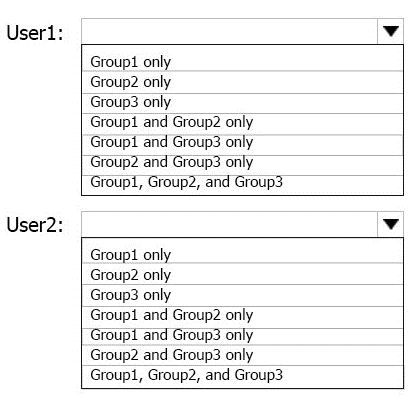HOTSPOT - (Topic 5)
You have an Azure subscription that contains the resources shown in the following table:
You assign a policy to RG6 as shown in the following table:
To RG6, you apply the tag: RGroup: RG6.
You deploy a virtual network named VNET2 to RG6. Which tags apply to VNET1 and VNET2? To answer, select the appropriate options in the answer area.
Which tags apply to VNET1 and VNET2? To answer, select the appropriate options in the answer area.
NOTE: Each correct selection is worth one point.
Solution:
https://learn.microsoft.com/en-us/azure/azure-resource-manager/management/tag-policies
Does this meet the goal?
Correct Answer:
A
HOTSPOT - (Topic 5)
You have an Azure Active Directory (Azure AD) tenant named adatum.com. Adatum.com contains the groups in the following table.
You create two user accounts that are configured as shown in the following table.
To which groups do User1 and User2 belong? To answer. select the appropriate options in the answer area.
NOTE: Each correct selection is worth one point.
Solution:
Box 1: Group 1 only First rule applies
Box 2: Group1 and Group2 only Both membership rules apply.
References: https://docs.microsoft.com/en-us/sccm/core/clients/manage/collections/create- collections
Does this meet the goal?
Correct Answer:
A
HOTSPOT - (Topic 5)
You have an Azure subscription named Sub1 that contains the Azure resources shown in the following table.
You assign an Azure policy that has the following settings:
✑ Scope: Sub1
✑ Exclusions: Sub1/RG1/VNET1
✑ Policy definition: Append a tag and its value to resources
✑ Policy enforcement: Enabled
✑ Tag name: Tag4
✑ Tag value: value4
You assign tags to the resources as shown in the following table.
For each of the following statements, select Yes if the statement is true. Otherwise, select No.
NOTE: Each correct selection is worth one point.
Solution:
✑ RG1 has the Tag2: IT tag assigned only. No, this is not correct. According to the tables, RG1 has two tags assigned: Tag2: IT and Tag3: value2. The Azure policy does not affect RG1, because it is excluded from the scope of the policy. Therefore, RG1 does not have the Tag4: value4 tag appended by the policy.
✑ Storage1 has the Tag1: subscription, Tag2: IT, Tag3: value1, and Tag4: value4 tags assigned. Yes, this is correct. According to the tables, Storage1 has three tags assigned: Tag1: subscription, Tag2: IT, and Tag3: value1. The Azure policy affects Storage1, because it is within the scope of the policy and not excluded. Therefore, Storage1 has the Tag4: value4 tag appended by the policy.
✑ VNET1 has the Tag2: IT and Tag3: value2 tags assigned only. Yes, this is correct. According to the tables, VNET1 has two tags assigned: Tag2: IT and Tag3: value2. The Azure policy does not affect VNET1, because it is excluded from the scope of the policy. Therefore, VNET1 does not have the Tag4: value4 tag appended by the policy.
According to the tables, VNET1 has two tags assigned: Tag2: IT and Tag3: value2. The Azure policy does not affect VNET1, because it is excluded from the scope of the policy. Therefore, VNET1 does not have the Tag4: value4 tag appended by the policy.
Does this meet the goal?
Correct Answer:
A
- (Topic 5)
You have an Azure Kubernetes Service (AKS) cluster named AKS1. You need to configure cluster autoscaler for AKS1.
Which two tools should you use? Each correct answer presents a complete solution, NOTE: Each correct selection is worth one point
Correct Answer:
BC
AKS clusters can scale in one of two ways: - The cluster autoscaler watches for pods that can't be scheduled on nodes because of resource constraints. The cluster then automatically increases the number of nodes. - The horizontal pod autoscaler uses the Metrics Server in a Kubernetes cluster to monitor the resource demand of pods. If an application needs more resources, the number of pods is automatically increased to meet the demand. Reference: https://docs.microsoft.com/en-us/azure/aks/cluster-autoscaler
HOTSPOT - (Topic 5)
You have an Azure App Service app named WebApp1 that contains two folders named Folder1 and Folder2.
You need to configure a daily backup of WebApp1. The solution must ensure that Folder2 is excluded from the backup.
What should you create first and what should you use to exclude Fokier2? To answer, select the appropriate options in the answer area.
NOTE: Each correct selection is worth one point.
Solution:
https://learn.microsoft.com/en-us/azure/app-service/manage-backup?tabs=portal#create-a-custom-backup
In Storage account, select an existing storage account (in the same subscription) or select Create new. Do the same with Container. https://learn.microsoft.com/en-us/azure/app-service/manage-backup?tabs=portal#configure-partial-backups
Partial backups are supported for custom backups (not for automatic backups). Sometimes you don't want to back up everything on your app. To exclude folders and files from being stored in your future backups, create a _backup.filter file in the %HOME%sitewwwroot folder of your app. Specify the list of files and folders you want to exclude in this file.
Does this meet the goal?
Correct Answer:
A